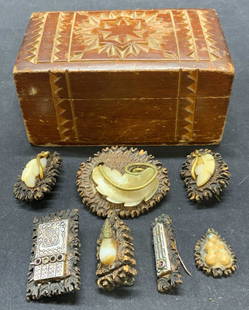
Viking Gilt-Bronze Box Brooch with Entwined Animals
Similar Sale History
View More Items in Brooches & PinsRelated Brooches & Pins
More Items in Brooches & Pins
View MoreRecommended Jewelry
View More


Item Details
Description
8th-9th century AD. A hollow-cast drum-shaped brooch with central cell to the upper face, red bead insert; the outer sidewall with lattice hatching, three dividing panels with knotwork motif; the upper face with beaded border and tribrach, three S-shaped animals in Salin's Style III; pin and catchplate to the reverse. See MacGregor, A. et al. A Summary Catalogue of the Continental Archaeological Collections (Roman Iron Age, Migration Period, Early Medieval), Oxford, 1997, item 1.9; Rydh, H. Dosformiga Spännen från Vikingatifden, Stockholm, 1919; Thunmark-Nylén, L. Vikingatida Dosspännen – Teknisk Stratigrafi och Verkstadsgruppering, Uppsala, 1983. 35 grams, 48mm (2"). Property of a 19th century collector; thence by descent. Drum brooches (also called ‘box brooches’, Swedish Dosspännen) were a Scandinavian fashion of the Viking period, beginning in the late 8th century AD and featuring Oseberg style gripping-beast motifs. They remained popular throughout the period into the 11th century AD. They are especially associated with the island of Gotland, the crossroads of trade and traffic in the Baltic where a variety of cultural influences were felt. Occasional examples occur elsewhere in the area of Scandinavian power, plausibly associated with the movement of brides from Gotland to foreign homelands. The earliest (8th century) examples are high-quality multi-part castings with lavish use of gold, parcel-gilding and silver; by the later Viking age they appear in bronze and gilt bronze. The original artistic motifs also evolve into more geometric forms with increased use of knotwork. As a type, they are characterised by their discoid upper face divided into symmetrical quarters often with openwork detail; cords and faux-ropework to the edges are a consistent feature of the design. Some feature a separate cast upper plate, and on others it is the baseplate which is separate, as on the present example. Occasionally the central knop is also a separate casting. It has been suggested that drum brooches were used to hold small valuables, although this seems improbable – these were normally suspended from the girdle or necklace for display. They were most probably used to fasten the triangular shawl or mantle which covered the upper body, in the dress fashion which included the heavy hängerok dress which was worn outside the undershift; the hängerok was often of rich fabric with embroidered borders, and the metal jewellery and glass beads were used to add richness to the costume. It may be this type of brooch (or the tortoise form) which was referred to by the Arab traveller Ibn Fadlan when he mentioned that Rus women wore on their chests drum-shaped brooches of iron, copper, silver or gold, whose decoration indicated the wealth of their husbands.
Condition
Extremely fine condition. Excessively rare, museum quality.
Buyer's Premium
- 24%
Viking Gilt-Bronze Box Brooch with Entwined Animals
Estimate £20,000 - £30,000
4 bidders are watching this item.
Shipping & Pickup Options
Item located in London, ukSee Policy for Shipping
Payment

Related Searches
TOP














































































